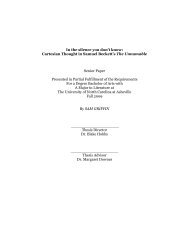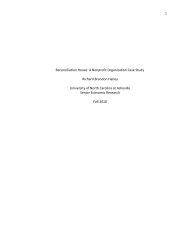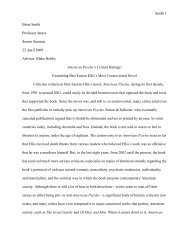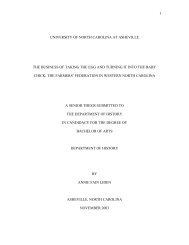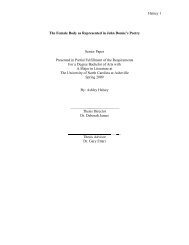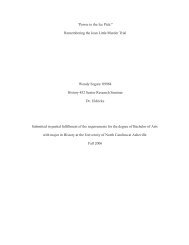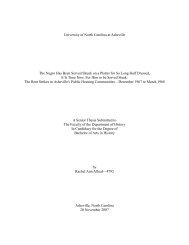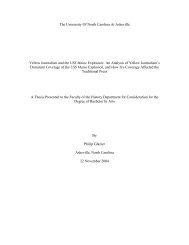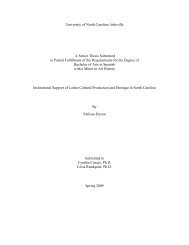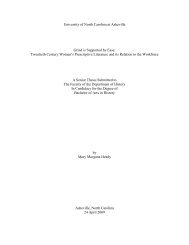To Test an Idea: Menippean Satire in Lawrence Durrell's Avignon ...
To Test an Idea: Menippean Satire in Lawrence Durrell's Avignon ...
To Test an Idea: Menippean Satire in Lawrence Durrell's Avignon ...
You also want an ePaper? Increase the reach of your titles
YUMPU automatically turns print PDFs into web optimized ePapers that Google loves.
Riley 9Piers has <strong>an</strong> <strong>in</strong>tellectual temperament that leads him to <strong>in</strong>tense theoretical study ofGnosticism, a major ideology questioned by the text. But though Piers devotes himself to thetheoretical study, he does not adhere to core pr<strong>in</strong>ciples of Gnosticism. The Gnostics supposedlyshun the world of matter for a more poetic existence. Akkad labels all Judeo-Christi<strong>an</strong> religions asa form of slavery to matter: “The presid<strong>in</strong>g demon is the spirit of matter, <strong>an</strong>d he spr<strong>in</strong>gs fullyarmed from the head of classical Judaism of which all Europe<strong>an</strong> religions are tributaries. Thepr<strong>in</strong>ce is usury, the spirit of ga<strong>in</strong>, the enigmatic power of capital value embodies <strong>in</strong> the poetry ofgold” (Monsieur 144-45). However, shortly after his study<strong>in</strong>g, Piers goes on a pleasure cruise withthree of his friends. Bruce is shocked by the abund<strong>an</strong>ce of Piers supplies: “you would have thoughtwe were mount<strong>in</strong>g <strong>an</strong> expedition to Polynesia to judge by the qu<strong>an</strong>tity of the stores which heordered” (Monsieur 154). Despite all of Akkad’s theoretical expositions, Akkad is not <strong>an</strong> ascetichermit but a successful bus<strong>in</strong>essm<strong>an</strong> who accepts <strong>an</strong>d thrives <strong>in</strong> a world he claims is evil. Hisblat<strong>an</strong>t participation <strong>in</strong> the world of matter underm<strong>in</strong>es his discourse on the spirit. First describedas a “merch<strong>an</strong>t-b<strong>an</strong>ker,” Akkad is “equally at home <strong>in</strong> four capitals <strong>an</strong>d four l<strong>an</strong>guages” (107).Sometimes he looks like “a fattish sluggish pasha, wallow<strong>in</strong>g <strong>in</strong> riches like a Turk,” other times“[b]eautifully dressed by London with a buttonhole <strong>an</strong>d a silk h<strong>an</strong>dkerchief” (107). Akkad’schameleon like existence may suggest that the theoretical underp<strong>in</strong>n<strong>in</strong>gs of Gnosticism,particularly the b<strong>in</strong>ary between Judaism <strong>an</strong>d Gnosticism, may only be a helpful myth rather th<strong>an</strong> adogmatic truth. Indeed, after his theoretical exposition of Gnosticism, the nature of truth isentirely put <strong>in</strong>to question. Akkad tests Piers’ faith by <strong>in</strong>sert<strong>in</strong>g a fake article about how the entiresect was created by crim<strong>in</strong>als <strong>in</strong> order to take adv<strong>an</strong>tage of gullible tourists. Piers is relieved to f<strong>in</strong>dthat Akkad pl<strong>an</strong>ted the article, but seems to miss the greater po<strong>in</strong>t Akkad tries to make. Akkadfully admits that there are aspects of the article that could be considered true: “you could question



